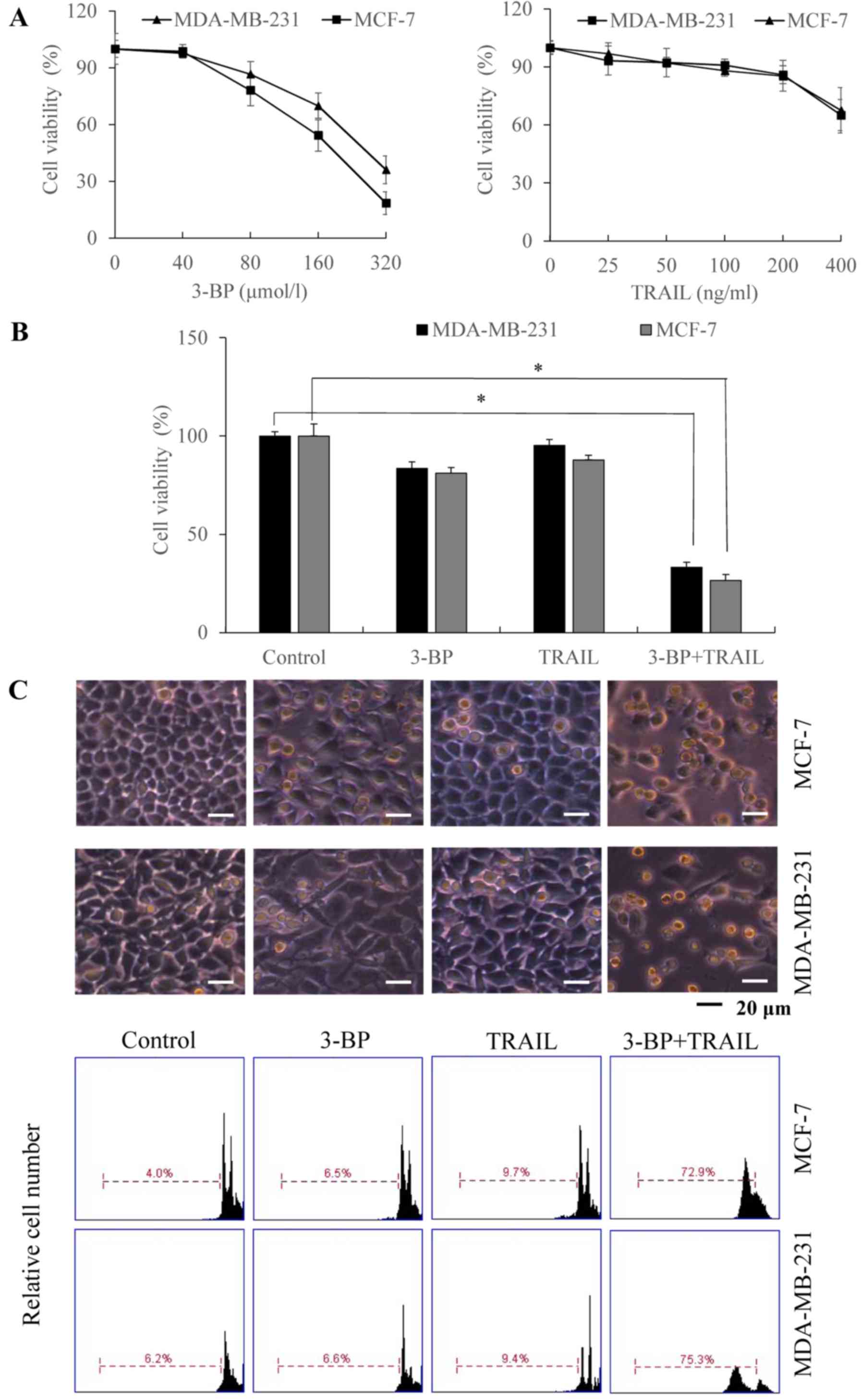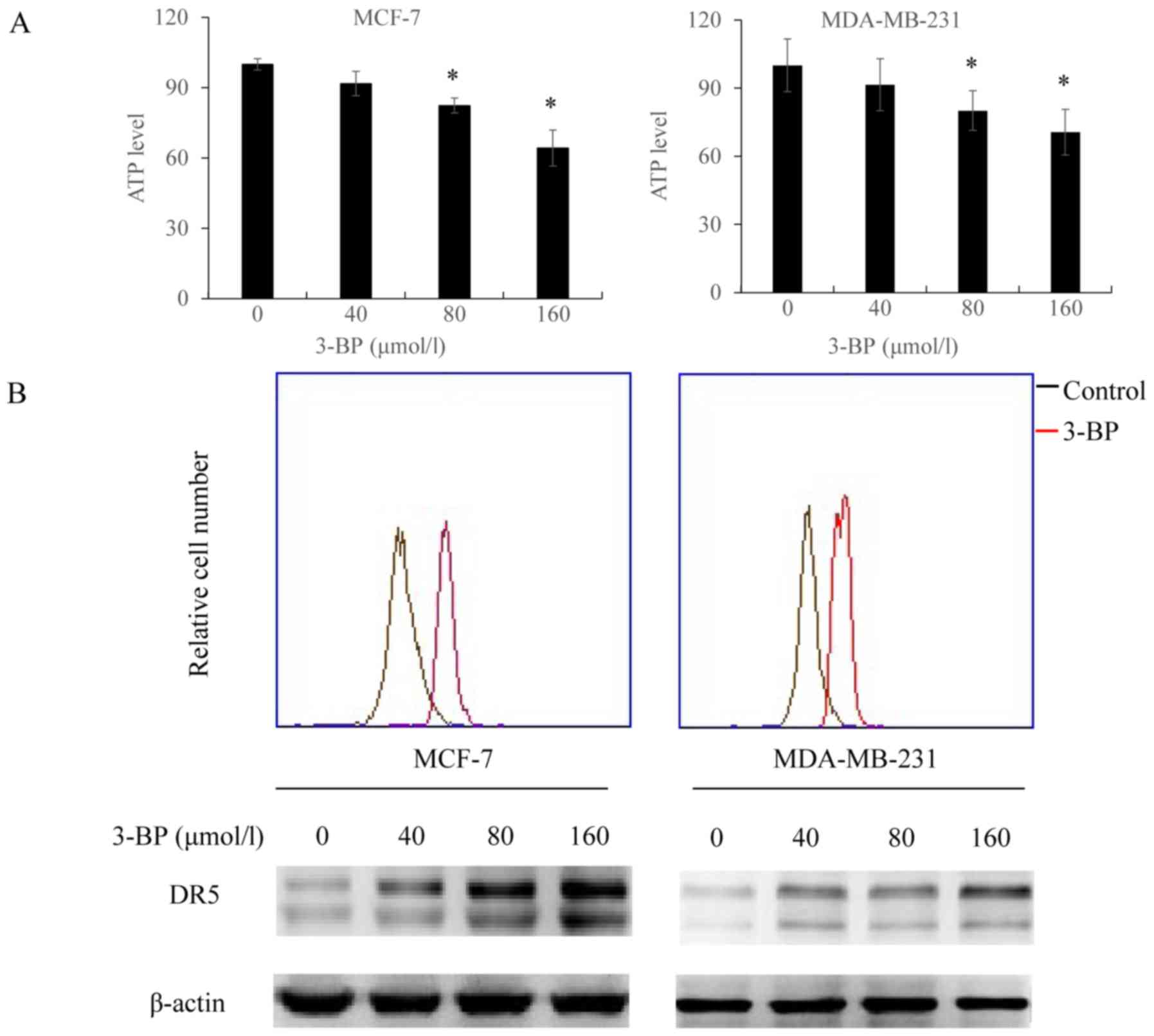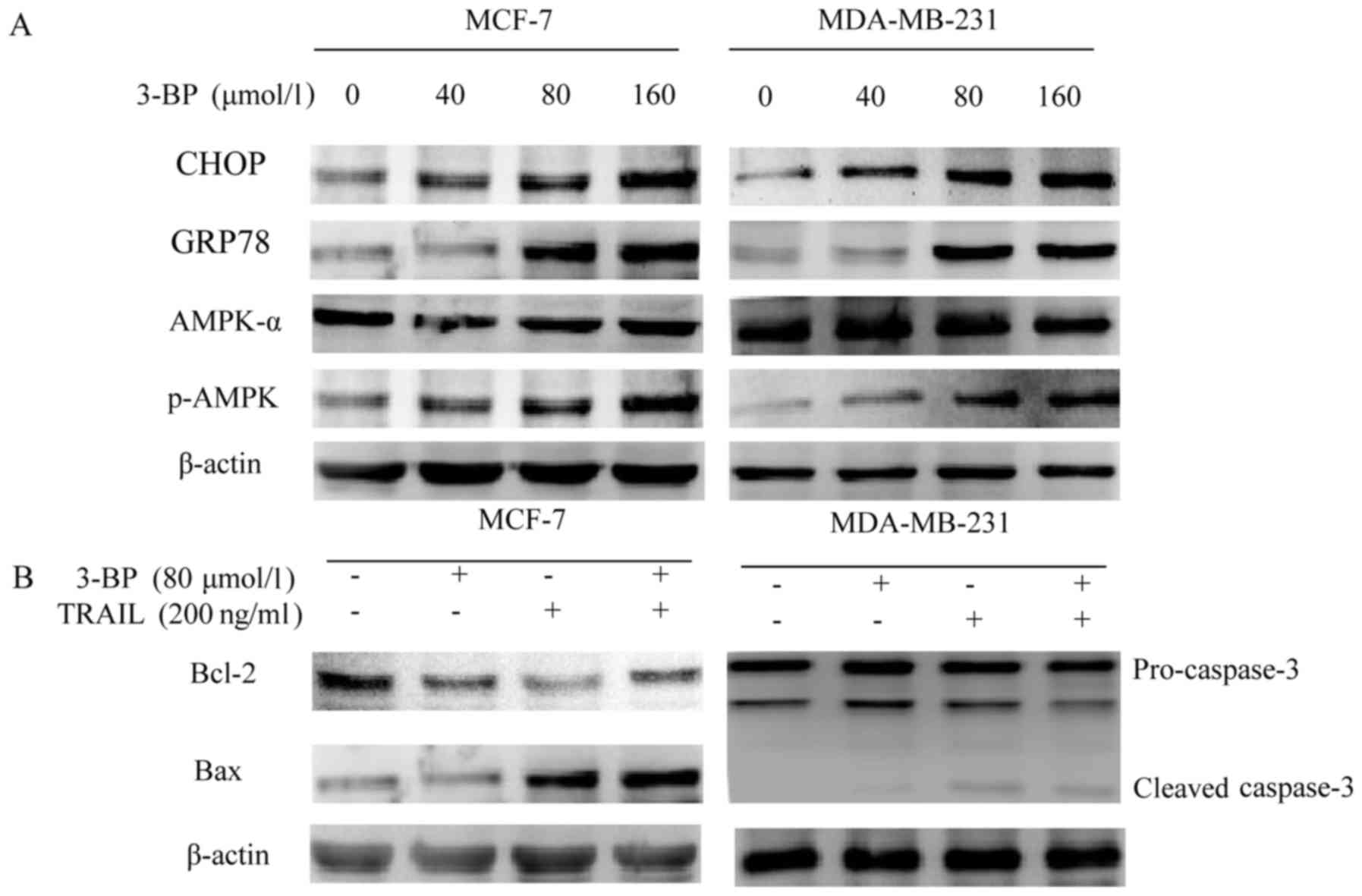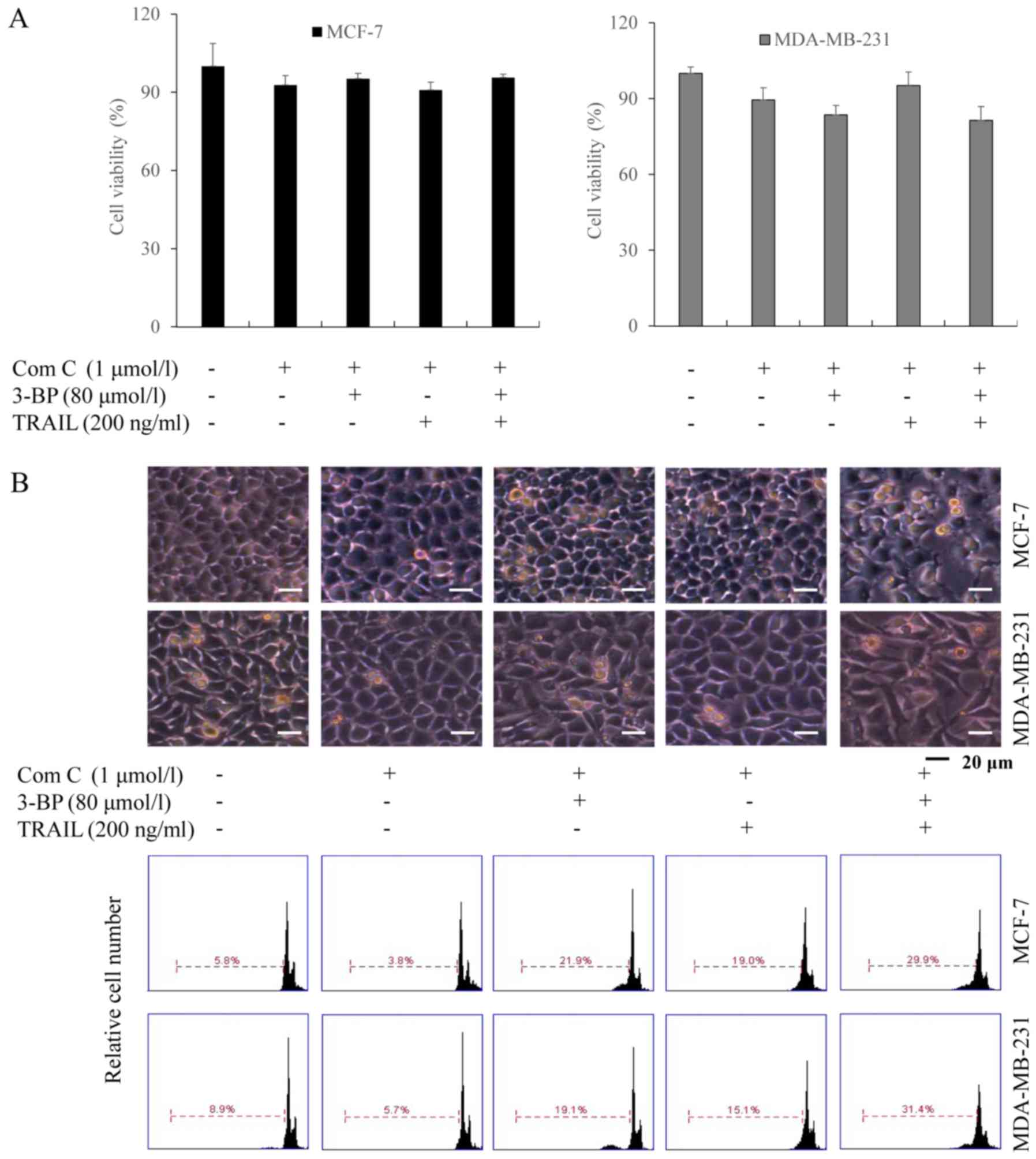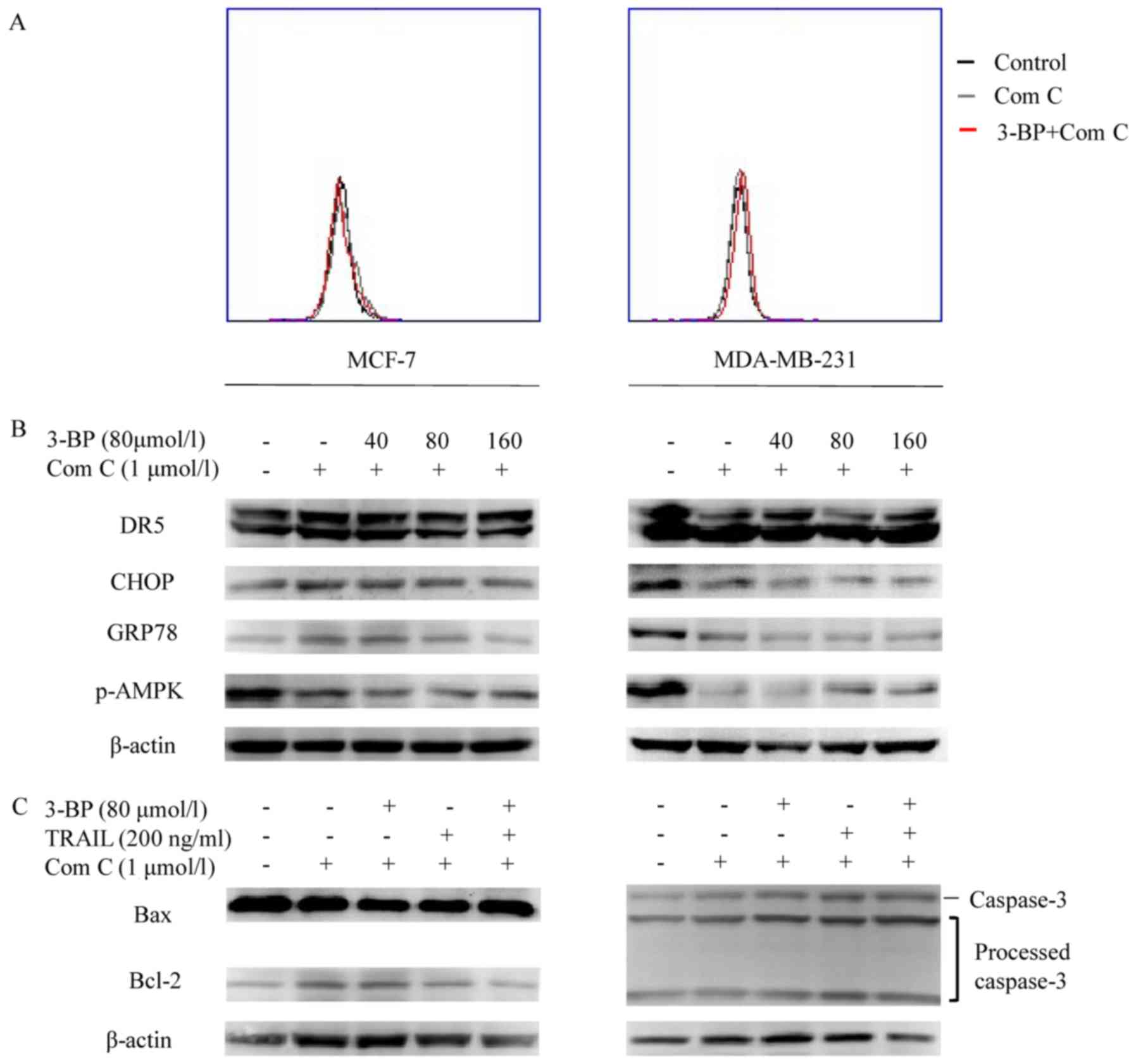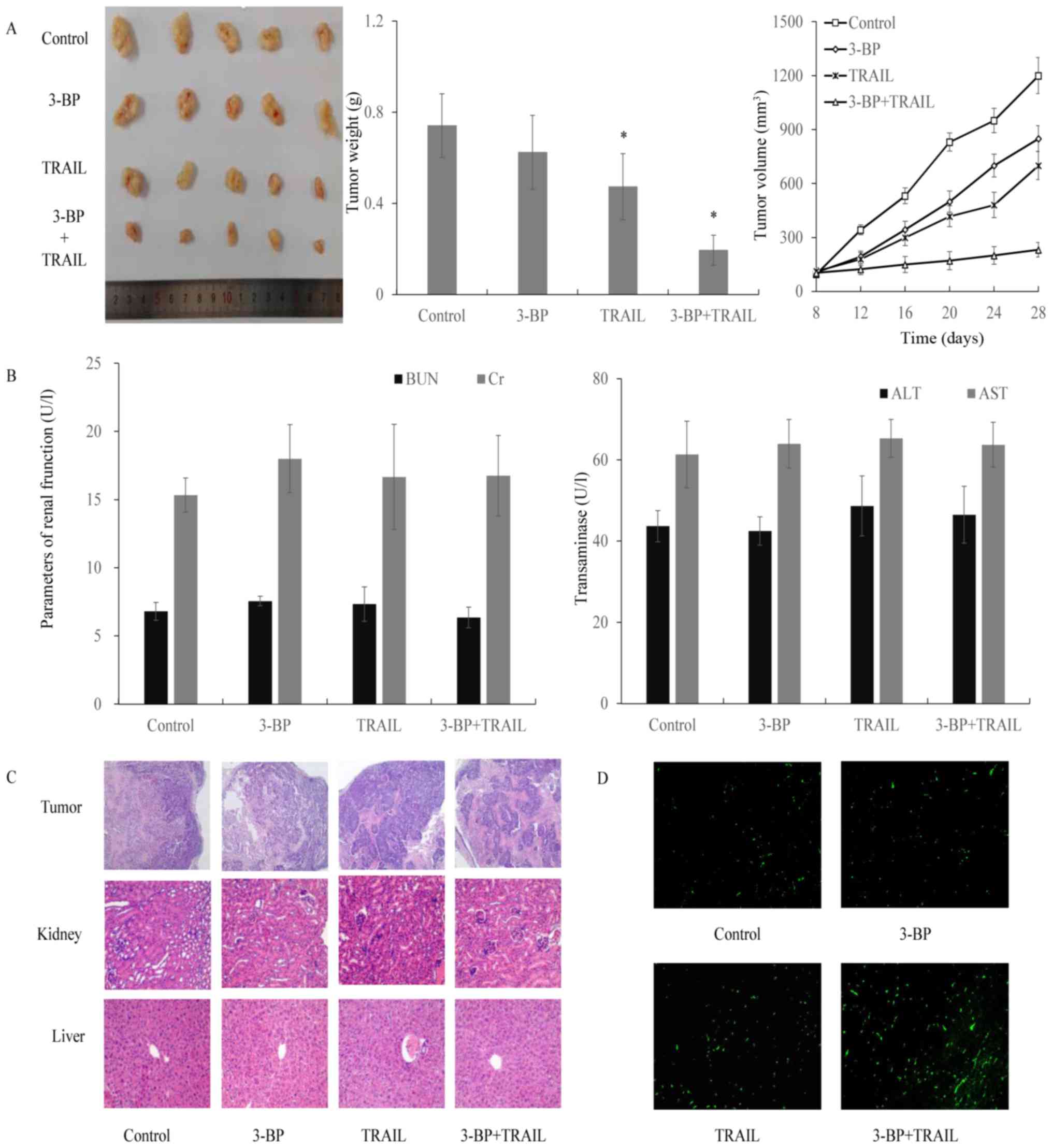|
1
|
Chen W, Zheng R, Baade PD, Zhang S, Zeng
H, Bray F, Jemal A, Yu XQ and He J: Cancer statistics in China,
2015. CA Cancer J Clin. 66:115–132. 2016. View Article : Google Scholar : PubMed/NCBI
|
|
2
|
Niraula S and Ocana A: Mechanism of drug
resistance in relation to site of metastasis: Meta-analyses of
randomized controlled trials in advanced breast cancer according to
anticancer strategy. Cancer Treat Rev. 50:168–174. 2016. View Article : Google Scholar : PubMed/NCBI
|
|
3
|
Hellwig CT and Rehm M: TRAIL signaling and
synergy mechanisms used in TRAIL-based combination therapies. Mol
Cancer Ther. 11:3–13. 2012. View Article : Google Scholar : PubMed/NCBI
|
|
4
|
Ashkenazi A and Herbst RS: To kill a tumor
cell: The potential of proapoptotic receptor agonists. J Clin
Invest. 118:1979–1990. 2008. View
Article : Google Scholar : PubMed/NCBI
|
|
5
|
Walczak H, Miller RE, Ariail K, Gliniak B,
Griffith TS, Kubin M, Chin W, Jones J, Woodward A, Le T, et al:
Tumoricidal activity of tumor necrosis factor-related
apoptosis-inducing ligand in vivo. Nat Med. 5:157–163. 1999.
View Article : Google Scholar : PubMed/NCBI
|
|
6
|
Ho TF and Chang CC: A promising ‘TRAIL’ of
tanshinones for cancer therapy. Biomedicine. 5:232015. View Article : Google Scholar : PubMed/NCBI
|
|
7
|
Ashkenazi A, Pai RC, Fong S, Leung S,
Lawrence DA, Marsters SA, Blackie C, Chang L, McMurtrey AE, Hebert
A, et al: Safety and antitumor activity of recombinant soluble Apo2
ligand. J Clin Invest. 104:155–162. 1999. View Article : Google Scholar : PubMed/NCBI
|
|
8
|
Kim EH, Yoon MJ, Kim SU, Kwon TK, Sohn S
and Choi KS: Arsenic trioxide sensitizes human glioma cells, but
not normal astrocytes, to TRAIL-induced apoptosis via
CCAAT/enhancer-binding protein homologous protein-dependent DR5
upregulation. Cancer Res. 68:266–275. 2008. View Article : Google Scholar : PubMed/NCBI
|
|
9
|
Liu H, Jiang CC, Lavis CJ, Croft A, Dong
L, Tseng HY, Yang F, Tay KH, Hersey P and Zhang XD:
2-Deoxy-D-glucose enhances TRAIL-induced apoptosis in human
melanoma cells through XBP-1-mediated upregulation of TRAIL-R2. Mol
Cancer. 8:1222009. View Article : Google Scholar : PubMed/NCBI
|
|
10
|
Hanahan D and Weinberg RA: Hallmarks of
cancer: The next generation. Cell. 144:646–674. 2011. View Article : Google Scholar : PubMed/NCBI
|
|
11
|
Warburg O: On the origin of cancer cells.
Science. 123:309–314. 1956. View Article : Google Scholar : PubMed/NCBI
|
|
12
|
Yu SJ, Yoon JH, Yang JI, Cho EJ, Kwak MS,
Jang ES, Lee JH, Kim YJ, Lee HS and Kim CY: Enhancement of
hexokinase II inhibitor-induced apoptosis in hepatocellular
carcinoma cells via augmenting ER stress and anti-angiogenesis by
protein disulfide isomerase inhibition. J Bioenerg Biomembr.
44:101–115. 2012. View Article : Google Scholar : PubMed/NCBI
|
|
13
|
Guo X, Meng Y, Sheng X, Guan Y, Zhang F,
Han Z, Kang Y, Tai G, Zhou Y and Cheng H: Tunicamycin enhances
human colon cancer cells to TRAIL-induced apoptosis by
JNK-CHOP-mediated DR5 upregulation and the inhibition of the EGFR
pathway. Anticancer Drugs. 28:66–74. 2017. View Article : Google Scholar : PubMed/NCBI
|
|
14
|
Chen P, Hu T, Liang Y, Li P, Chen X, Zhang
J, Ma Y, Hao Q, Wang J, Zhang P, et al: Neddylation inhibition
activates the extrinsic apoptosis pathway through ATF4-CHOP-DR5
axis in human esophageal cancer cells. Clin Cancer Res.
22:4145–4157. 2016. View Article : Google Scholar : PubMed/NCBI
|
|
15
|
Lu M, Lawrence DA, Marsters S,
Acosta-Alvear D, Kimmig P, Mendez AS, Paton AW, Paton JC, Walter P
and Ashkenazi A: Opposing unfolded-protein-response signals
converge on death receptor 5 to control apoptosis. Science.
345:98–101. 2014. View Article : Google Scholar : PubMed/NCBI
|
|
16
|
Lopez M, Nogueiras R, Tena-Sempere M and
Diéguez C: Hypothalamic AMPK: A canonical regulator of whole-body
energy balance. Nat Rev Endocrinol. 12:421–432. 2016. View Article : Google Scholar : PubMed/NCBI
|
|
17
|
Carling D and Viollet B: Beyond energy
homeostasis: The expanding role of AMP-activated protein kinase in
regulating metabolism. Cell Metab. 21:799–804. 2015. View Article : Google Scholar : PubMed/NCBI
|
|
18
|
Graf D, Reinehr R, Kurz AK, Fischer R and
Häussinger D: Inhibition of taurolithocholate 3-sulfate-induced
apoptosis by cyclic AMP in rat hepatocytes involves protein kinase
A-dependent and -independent mechanisms. Arch Biochem Biophys.
415:34–42. 2003. View Article : Google Scholar : PubMed/NCBI
|
|
19
|
Dhanasekaran DN and Reddy EP: JNK
signaling in apoptosis. Oncogene. 27:6245–6251. 2008. View Article : Google Scholar : PubMed/NCBI
|
|
20
|
Bodur C, Karakas B, Timucin AC, Tezil T
and Basaga H: AMP-activated protein kinase couples
3-bromopyruvate-induced energy depletion to apoptosis via
activation of FoxO3a and upregulation of proapoptotic Bcl-2
proteins. Mol Carcinog. 55:1584–1597. 2016. View Article : Google Scholar : PubMed/NCBI
|
|
21
|
Sun Y, Liu Z, Zou X, Lan Y, Sun X, Wang X,
Zhao S, Jiang C and Liu H: Mechanisms underlying
3-bromopyruvate-induced cell death in colon cancer. J Bioenerg
Biomembr. 47:319–329. 2015. View Article : Google Scholar : PubMed/NCBI
|
|
22
|
Torre LA, Bray F, Siegel RL, Ferlay J,
Lortet-Tieulent J and Jemal A: Global cancer statistics, 2012. CA
Cancer J Clin. 65:87–108. 2015. View Article : Google Scholar : PubMed/NCBI
|
|
23
|
Francis A, Thomas J, Fallowfield L, Wallis
M, Bartlett JM, Brookes C, Roberts T, Pirrie S, Gaunt C, Young J,
et al: Addressing overtreatment of screen detected DCIS; the LORIS
trial. Eur J Cancer. 51:2296–2303. 2015. View Article : Google Scholar : PubMed/NCBI
|
|
24
|
Huang K, Zhang J, O'Neill KL, Gurumurthy
CB, Quadros RM, Tu Y and Luo X: Cleavage by Caspase 8 and
mitochondrial membrane association activate the BH3-only protein
bid during TRAIL-induced apoptosis. J Biol Chem. 291:11843–11851.
2016. View Article : Google Scholar : PubMed/NCBI
|
|
25
|
Wilson NS, Yang A, Yang B, Couto S, Stern
H, Gogineni A, Pitti R, Marsters S, Weimer RM, Singh M, et al:
Proapoptotic activation of death receptor 5 on tumor endothelial
cells disrupts the vasculature and reduces tumor growth. Cancer
Cell. 22:80–90. 2012. View Article : Google Scholar : PubMed/NCBI
|
|
26
|
Akazawa Y, Mott JL, Bronk SF, Werneburg
NW, Kahraman A, Guicciardi ME, Meng XW, Kohno S, Shah VH, Kaufmann
SH, et al: Death receptor 5 internalization is required for
lysosomal permeabilization by TRAIL in malignant liver cell lines.
Gastroenterology. 136(2365–2376): e1–e7. 2009.
|
|
27
|
Pennarun B, Meijer A, de Vries EG,
Kleibeuker JH, Kruyt F and de Jong S: Playing the DISC: Turning on
TRAIL death receptor-mediated apoptosis in cancer. Biochim Biophys
Acta. 1805:123–140. 2010.PubMed/NCBI
|
|
28
|
Knoll G, Bittner S, Kurz M, Jantsch J and
Ehrenschwender M: Hypoxia regulates TRAIL sensitivity of colorectal
cancer cells through mitochondrial autophagy. Oncotarget.
7:41488–41504. 2016. View Article : Google Scholar : PubMed/NCBI
|
|
29
|
Iaboni M, Russo V, Fontanella R, Roscigno
G, Fiore D, Donnarumma E, Esposito CL, Quintavalle C, Giangrande
PH, de Franciscis V, et al: Aptamer-miRNA-212 conjugate sensitizes
NSCLC cells to TRAIL. Molecular therapy. Mol Ther Nucleic Acids.
5:e2892016. View Article : Google Scholar : PubMed/NCBI
|
|
30
|
Tameire F, Verginadis II and Koumenis C:
Cell intrinsic and extrinsic activators of the unfolded protein
response in cancer: Mechanisms and targets for therapy. Semin
Cancer Biol. 33:3–15. 2015. View Article : Google Scholar : PubMed/NCBI
|
|
31
|
Senft D and Ronai ZA: UPR, autophagy, and
mitochondria crosstalk underlies the ER stress response. Trends
Biochem Sci. 40:141–148. 2015. View Article : Google Scholar : PubMed/NCBI
|
|
32
|
Hetz C: The unfolded protein response:
Controlling cell fate decisions under ER stress and beyond. Nat Rev
Mol Cell Biol. 13:89–102. 2012. View Article : Google Scholar : PubMed/NCBI
|
|
33
|
Oyadomari S and Mori M: Roles of
CHOP/GADD153 in endoplasmic reticulum stress. Cell Death Differ.
11:381–389. 2004. View Article : Google Scholar : PubMed/NCBI
|
|
34
|
Dilshara MG, Jayasooriya RG, Park SR, Choi
YH, Choi IW and Kim GY: Caffeic acid phenethyl ester enhances
TRAIL-mediated apoptosis via CHOP-induced death receptor 5
upregulation in hepatocarcinoma Hep3B cells. Mol Cell Biochem.
418:13–20. 2016. View Article : Google Scholar : PubMed/NCBI
|
|
35
|
Galluzzi L, Maiuri MC, Vitale I, Zischka
H, Castedo M, Zitvogel L and Kroemer G: Cell death modalities:
Classification and pathophysiological implications. Cell Death
Differ. 14:1237–1243. 2007. View Article : Google Scholar : PubMed/NCBI
|
|
36
|
Brahmbhatt H, Oppermann S, Osterlund EJ,
Leber B and Andrews DW: Molecular pathways: Leveraging the BCL-2
interactome to kill cancer cells-mitochondrial outer membrane
permeabilization and beyond. Clin Cancer Res. 21:2671–2676. 2015.
View Article : Google Scholar : PubMed/NCBI
|
|
37
|
Green DR and Llambi F: Cell death
signaling. Cold Spring Harb Perspect Biol. 7:pii: a006080. 2015.
View Article : Google Scholar : PubMed/NCBI
|
|
38
|
Jänicke RU: MCF-7 breast carcinoma cells
do not express caspase-3. Breast Cancer Res Treat. 117:219–221.
2009. View Article : Google Scholar : PubMed/NCBI
|
|
39
|
Lu PH, Chen MB, Ji C, Li WT, Wei MX and Wu
MH: Aqueous Oldenlandia diffusa extracts inhibits colorectal cancer
cells via activating AMP-activated protein kinase signalings.
Oncotarget. 7:45889–45900. 2016.PubMed/NCBI
|
|
40
|
Lennon JC, Butini S, Campiani G, O'Meara
A, Williams DC and Zisterer DM: Involvement of AMP-activated
protein kinase in mediating pyrrolo-1,5-benzoxazepine-induced
apoptosis in neuroblastoma cells. Invest New Drugs. 34:663–676.
2016. View Article : Google Scholar : PubMed/NCBI
|
|
41
|
Jiang Z, Chen X, Chen K, Sun L, Gao L,
Zhou C, Lei M, Duan W, Wang Z, Ma Q and Ma J: YAP inhibition by
resveratrol via activation of AMPK enhances the sensitivity of
pancreatic cancer cells to gemcitabine. Nutrients. 8:pii: E546.
2016. View Article : Google Scholar
|
|
42
|
Han MA, Min KJ, Woo SM, Seo BR and Kwon
TK: Eupafolin enhances TRAIL-mediated apoptosis through cathepsin
S-induced down-regulation of Mcl-1 expression and AMPK-mediated Bim
upregulation in renal carcinoma Caki cells. Oncotarget.
7:65707–65720. 2016. View Article : Google Scholar : PubMed/NCBI
|
|
43
|
Meynet O, Zunino B, Happo L, Pradelli LA,
Chiche J, Jacquin MA, Mondragón L, Tanti JF, Taillan B, Garnier G,
et al: Caloric restriction modulates Mcl-1 expression and
sensitizes lymphomas to BH3 mimetic in mice. Blood. 122:2402–2411.
2013. View Article : Google Scholar : PubMed/NCBI
|
|
44
|
Pradelli LA, Bénéteau M, Chauvin C,
Jacquin MA, Marchetti S, Muñoz-Pinedo C, Auberger P, Pende M and
Ricci JE: Glycolysis inhibition sensitizes tumor cells to death
receptors-induced apoptosis by AMP kinase activation leading to
Mcl-1 block in translation. Oncogene. 29:1641–1652. 2010.
View Article : Google Scholar : PubMed/NCBI
|















